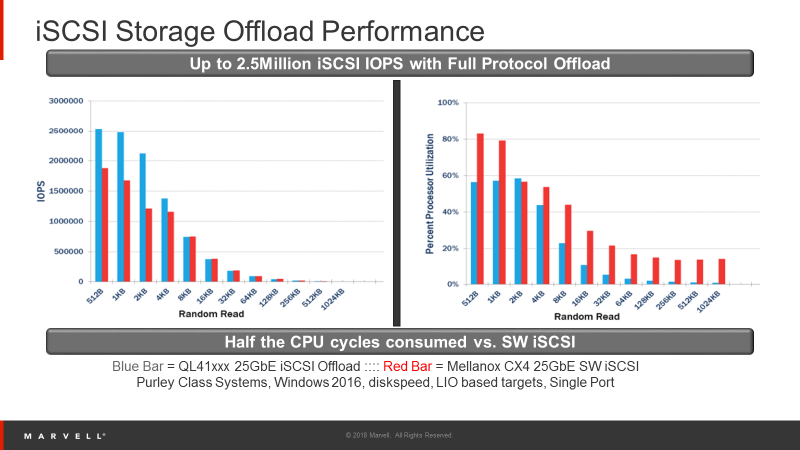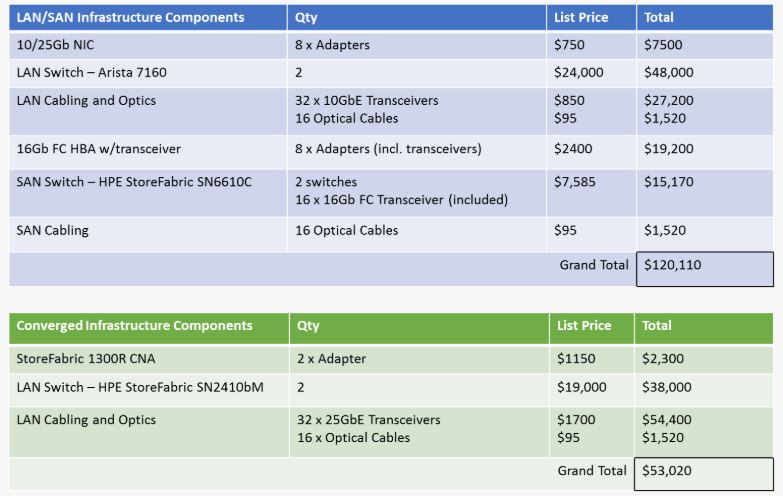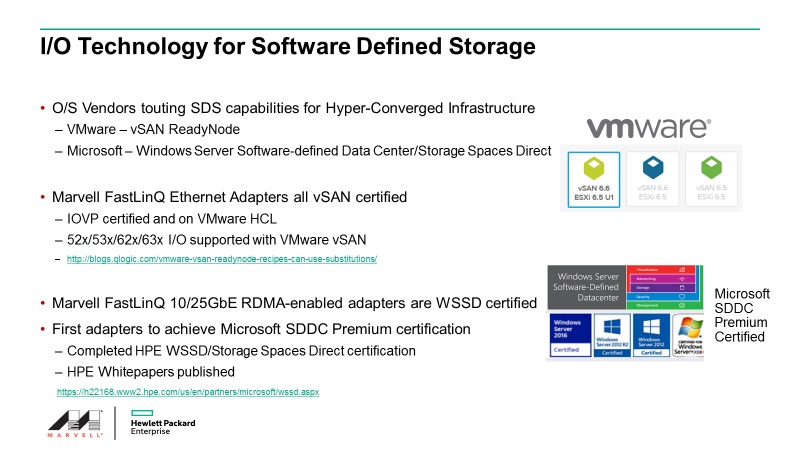

By Gidi Navon, Senior Principal Architect, Marvell

The current environment and an expected “new normal” are driving the transition to a borderless enterprise that must support increasing performance requirements and evolving business models. The infrastructure is seeing growth in the number of endpoints (including IoT) and escalating demand for data such as high-definition content. Ultimately, wired and wireless networks are being stretched as data-intensive applications and cloud migrations continue to rise.
By Todd Owens, Field Marketing Director, Marvell
Converging network and storage I/O onto a single wire can drive significant cost reductions in the small to mid-size data center by reducing the number of connections required. Fewer adapter ports means fewer cables, optics and switch ports consumed, all of which reduce OPEX in the data center. Customers can take advantage of converged I/O by deploying Converged Network Adapters (CNA) that provide not only networking connectivity, but also provide storage offloads for iSCSI and FCoE as well.
Just recently, HPE has introduced two new CNAs based on Marvell® FastLinQ® 41000 Series technology. The HPE StoreFabric CN1200R 10GBASE-T Converged Network Adapter and HPE StoreFabric CN1300R 10/25Gb Converged Network Adapter are the latest additions in HPE’s CNA portfolio. These are the only HPE StoreFabric CNAs to also support Remote Direct Memory Access (RDMA) technology (concurrently with storage offloads).
As we all know, the amount of data being generated continues to increase and that data needs to be stored somewhere. Recently, we are seeing an increase in the number of iSCSI connected storage devices in mid-market, branch and campus environments. iSCSI is great for these environments because it is easy to deploy, it can run on standard Ethernet, and there are a variety of new iSCSI storage offerings available, like Nimble and MSA all flash storage arrays (AFAs).
One challenge with iSCSI is the load it puts on the Server CPU for storage traffic processing when using software initiators – a common approach to storage connectivity. To combat this, Storage Administrators can turn to CNAs with full iSCSI protocol offload. Offloading transfers the burden of processing the storage I/O from the CPU to the adapter.  Figure 1: Benefits of Adapter Offloads
Figure 1: Benefits of Adapter Offloads
As Figure 1 shows, Marvell driven testing shows that CPU utilization using H/W offload in FastLinQ 10/25GbE adapters can reduce CPU utilization by as much as 50% compared to an Ethernet NIC with software initiators. This means less burden on the CPU, allowing you to add more virtual machines per server and potentially reducing the number of physical servers required. A small item like an intelligent I/O adapter from Marvell can provide a significant TCO savings.
Another challenge has been the latency associated with Ethernet connectivity. This can now be addressed with RDMA technology. iWARP, RDMA over Converged Ethernet (RoCE) and iSCSI over Ethernet with RDMA (iSER) all allow for I/O transactions to be performed directly from the memory to the adapter, bypassing the software kernel in the user space of the O/S. This speeds transactions and reduces the overall I/O latency. The result is better performance and faster applications.
The new HPE StoreFabric CNAs become the ideal devices for converging network and iSCSI storage traffic for HPE ProLiant and Apollo customers. The HPE StoreFabric CN1300R 10/25GbE CNA supports plenty of bandwidth that can be allocated to both the network and storage traffic. In addition, with support for Universal RDMA (support for both iWARP and RoCE) as well as iSER, this adapter provides significantly lower latency than standard network adapters for both the network and storage traffic.
The HPE StoreFabric 1300R also supports a technology Marvell calls SmartAN™, which allows the adapter to automatically configure itself when transitioning between 10GbE and 25GbE networks. This is key because at 25GbE speeds, Forward Error Correction (FEC) can be required, depending on the cabling used. To make things more complex, there are two different types of FEC that can be implemented. To eliminate all the complexity, SmartAN automatically configures the adapter to match the FEC, cabling and switch settings for either 10GbE or 25GbE connections, with no user intervention required.
When budget is the key concern, the HPE StoreFabric CN1200R is the perfect choice. Supporting 10GBASE-T connectivity, this adapter connects to existing CAT6A copper cabling using RJ-45 connections. This eliminates the need for more expensive DAC cables or optical transceivers. The StoreFabric CN1200R also supports RDMA protocols (iWARP, RoCE and iSER) for lower overall latency.
Why converge though? It’s all about a tradeoff between cost and performance. If we do the math to compare the cost of deploying separate LAN and storage networks versus a converged network, we can see that converging I/O greatly reduces the complexity of the infrastructure and can reduce acquisition costs by half. There are additional long-term cost savings also, associated with managing one network versus two.  Figure 2: Eight Server Network Infrastructure Comparison
Figure 2: Eight Server Network Infrastructure Comparison
In this pricing scenario, we are looking at eight servers connecting to separate LAN and SAN environments versus connecting to a single converged environment as shown in figure 2.  Table 1: LAN/SAN versus Converged Infrastructure Price Comparison
Table 1: LAN/SAN versus Converged Infrastructure Price Comparison
The converged environment price is 55% lower than the separate network approach. The downside is the potential storage performance impact of moving from a Fibre Channel SAN in the separate network environment to a converged iSCSI environment. The iSCSI performance can be increased by implementing a lossless Ethernet environment using Data Center Bridging and Priority Flow Control along with RoCE RDMA. This does add significant networking complexity but will improve the iSCSI performance by reducing the number of interrupts for storage traffic.
One additional scenario for these new adapters is in Hyper-Converged Infrastructure (HCI) implementations. With HCI, software defined storage is used. This means storage within the servers is shared across the network. Common implementations include Windows Storage Spaces Direct (S2D) and VMware vSAN Ready Node deployments. Both the HPE StoreFabric CN1200R BASE-T and CN1300R 10/25GbE CNAs are certified for use in either of these HCI implementations.  Figure 3: FastLinQ Technology Certified for Microsoft WSSD and VMware vSAN Ready Node
Figure 3: FastLinQ Technology Certified for Microsoft WSSD and VMware vSAN Ready Node
In summary, the new CNAs from the HPE StoreFabric group provide high performance, low cost connectivity for converged environments. With support for 10Gb and 25Gb Ethernet bandwidths, iWARP and RoCE RDMA and the ability to automatically negotiate changes between 10GbE and 25GbE connections with SmartAN™ technology, these are the ideal I/O connectivity options for small to mid-size server and storage networks. To get the most out over your server investments, choose Marvell FastLinQ Ethernet I/O technology which is engineered from the start with performance, total cost of ownership, flexibility and scalability in mind.
For more information on converged networking, contact one our HPE experts in the field to talk through your requirements. Just use the HPE Contact Information link on our HPE Microsite at www.marvell.com/hpe.
Copyright © 2025 Marvell, All rights reserved.